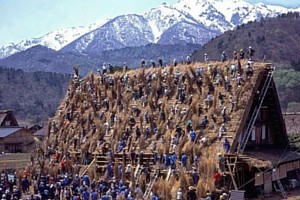 Working hard is a tradition in Japan. Nowhere is this clearer than in Shirakawa-go, a remote farming village located in the mountainous region of Honshu between Takayama and Kanazawa. Shirakawa-go, now a UNESCO World Heritage site, is an outstanding example of a traditional way of life perfectly adapted to the environment and the resident’s social and economic circumstances.
Working hard is a tradition in Japan. Nowhere is this clearer than in Shirakawa-go, a remote farming village located in the mountainous region of Honshu between Takayama and Kanazawa. Shirakawa-go, now a UNESCO World Heritage site, is an outstanding example of a traditional way of life perfectly adapted to the environment and the resident’s social and economic circumstances.
The village was founded in the late 12th century by survivors of the Heike clan. Virtually wiped out by the Genji clan in a brutal battle in 1185, the Heike followed the Sho River deep into the densely forested Japan Alps until they found an isolated valley in which to settle. Here they developed a unique style of wooden farm houses with thickly thatched roofs that can resist the high winds and deep snows of winter.
On the day we visited, the weather was mild and sunny. Shirakawa-go has three parts: a vast parking area with tourist facilities, an uninhabited outdoor museum of traditional farm houses, and, across the river, the historic village that is still inhabited.
The latter is idyllic. The mountainside literally gushes with water, which has been carefully channeled to sustain the rice fields and vegetable and flower gardens that are attached to each house. Tourists are free to roam as long as they respect the inhabitants and don’t barge into occupied homes. It is possible to explore one or two of these uninhabited, thickly timbered, two story houses. But the real story of these unique buildings is told in a videotape in the museum village that demonstrates how these homes are built using only local materials.
The building process is incredibly complex, especially the thatching process. This utilizes a special grass, which the farm families grew and stored. The grasses are bound into bundles and attached to the steep roofs. This involves the labor of the whole village, for the men must climb up on the roofs, position the thatch and tie the bundles to the log framing of the roof, layer after layer to a depth of three feet. When complete, these houses can stand for 300 years, a testament to human effort, craft, and cooperation.
[image from http://lucky-japan.blogspot.com/]
